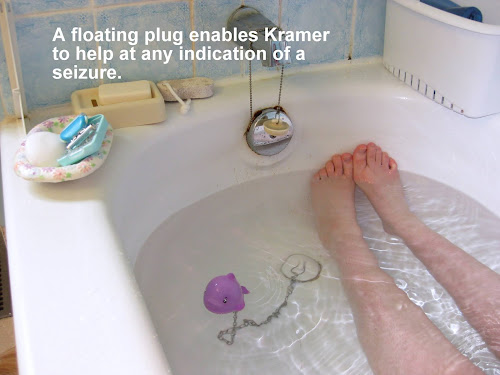Tuesday, July 28, 2020
Public Access
Friday, July 24, 2020
Rules when encountering a service dog
Blog: https://cablescalling.blogspot.com/
Facebook: https://www.facebook.com/pg/Cables-Calling-Born-to-be-a-Service-Dog-101555021631826/posts/
Sunday, July 19, 2020
Puppy Pics! A bit about the breeder.
We were honoured to have Kira donated to Amanda from Greylaur Goldens almost eight years ago. Now that Kira is nearing retirement, we are so very lucky that Greylaur Goldens has again chosen Amanda to be the recipient of a future service dog.
Friday, July 17, 2020
What is epilepsy?
SEIZURE/POST SEIZURE SAFETY
Tuesday, July 14, 2020
Monday, July 13, 2020
Building a normal life... baths!
Building a normal life for someone with epilepsy takes planning. Baths can be dangerous. Both the heat and the reflections on the water act as triggers for Amanda’s seizures. While she lived with the family we did find a way for her to enjoy a bath. Precautions had to be put in place including that someone had to be close by in the next room, and that a phone, emergency meds and a list of emergency phone numbers were on the ledge in the hallway just in case.
If Amanda had a generalized seizure in the bathtub, she could usually get the word, “Mom” out before she lost consciousness. Her hand would begin to jerk and splash the water.
Amanda’s first service dog trainer, Jac Harbour, provided her with a bath tub plug that had a floating toy attached to the chain, and taught Kramer to react to the signals of the call for “Mom” and the splashing water by pulling the plug, and running to get help. This way the water would drain, stopping Amanda from slipping underneath while the dog alerted an adult that there was an emergency.
The pictures below are a simulation showing Kramer demonstrating this skill. After locating an adult the dog will then lead them back to the tub to provide assistance.
Of course, if Amanda is home alone, a shower is the alternative.
Please share our page and our GO FUND ME link below. Thanks!
https://www.gofundme.com/…/cables-calling-born-to-be-a-serv…
#CablesCalling #servicedogtasks #workingdogs #seizureresponsedog #seizures #epilepsy
Disorientation
Street Safety
This set of pictures will explain how a service dog works to keep Amanda safe. Today's photos focus on street safety and feature Amanda's first service dog, Kramer.
Stay tuned for additional segments in the days to come!
Street safety is an important skill for Amanda's service dog to provide for her. Amanda wears a wraparound leash that attaches the dog to her waist. When she is ready to cross the street, her dog will wait for a command. During seizure, Amanda might continue walking automatically and unaware, but the leash will restrict her from stepping into the street unless she is able to verbalize the correct command.
Should traffic be coming, the dog will also hold firm and prevent Amanda from walking on, even if she does give the command.
If Amanda begins crossing a busy road and then feels a seizure about to start, she can give another command for the dog to pull her quickly across the street and safely to the other side.
This was the main safety concern when a service dog was first suggested to our family. We are so grateful Amanda is able to walk independently and safely throughout the community with her dog! Cable will learn these skills too!
How a seizure-response dog helps Amanda
How does a seizure-response dog help with Amanda's seizures?
Seizures are very unpredictable. They can occur suddenly or with a little warning called an aura. The aura is sometimes a feeling or sensation that something is wrong. In Amanda's case, she goes temporarily blind.
If Kira intervenes and begins licking Amanda's hand soon enough, this is often enough to stop the seizure from progressing into a cluster of seizures or a longer, convulsive seizure with loss of consciousness.
If Amanda is able to give the command, "Brace" before the seizure takes hold, Kira will help Amanda to lower herself to the ground using Kira to steady herself.
Once on the ground, Kira licks Amanda's hand to help her come out of the seizure before it progresses. Kira will stay with Amanda and not allow her to try to stand back up until Amanda is actually able to do so.
A safe way to help!
Winter Happenings with Cable
Cable had a busy fall and Christmas and is working hard with Brooke Nishio of T.E.A.M. Canines to complete her service dog training. Here ...

-
Cable had a busy fall and Christmas and is working hard with Brooke Nishio of T.E.A.M. Canines to complete her service dog training. Here ...
-
A trip down memory lane! Amanda was partnered with Kramer in 2008. Kramer met Kira in 2012. Kira met Cable in 2020. So much loving, can...
-
Cable is learning every day. In the short time she has been at RuffSport with Heather McLeod, she has socialized with other puppies and old...
















































